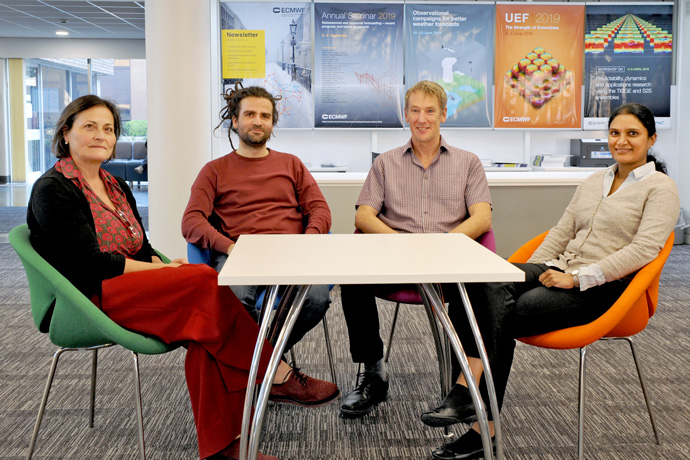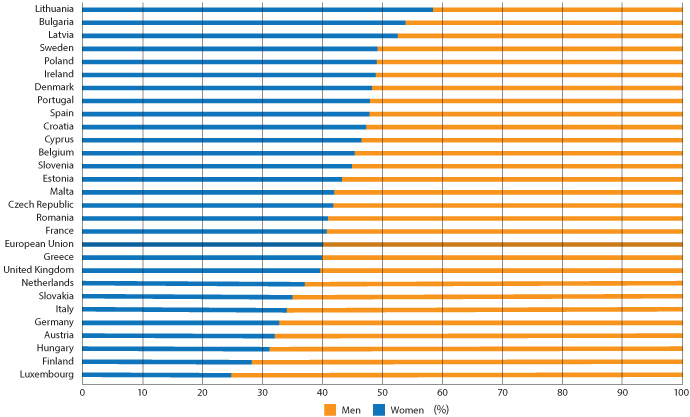

From left to right: Laura Ferranti, Gabriele Arduini, Erik Andersson and Beena Balan Sarojini.
On the occasion of International Women’s Day 2019, we brought together four ECMWF scientists, two women and two men whose scientific training spans six countries and the period 1981 to 2017, to talk about why there are so few women in science.
There is more common ground in their answers than you might expect.
The personal
All four agree that encouragement is an important factor in steering girls or boys towards science.
“I think a lack of confidence stops many girls from going into some areas of science,” says Laura Ferranti, a Principal Scientist in the Forecast Department.
She adds that her parents and two brothers were supportive when she decided to study physics in Italy in the mid-eighties, in her quest to understand how the world works. In the nineties, former UK Met Office Chief Scientist Dame Julia Slingo encouraged her to complete a PhD to grow in her career.
Deputy Director of Forecasts Erik Andersson studied physics and meteorology in Sweden in the early eighties “because that’s what I thought I’d be good at”. He, too, was nudged into doing a PhD in the late nineties to develop his career prospects.
Gabriele Arduini, a scientist in the Research Department who completed his PhD in France and the UK in 2017, studied physics in Italy “because I was fascinated by the subject’s beauty, but also because my dad was always making things and I liked that practical aspect”.
Beena Balan Sarojini, a scientist in the Research Department, studied physics and oceanography in India and completed a PhD in Germany in 2006. She says her parents wanted her to become a lawyer but were happy to settle for a career in science when she told them that’s what she wanted to do.
“Girls may well have it instilled in them at an early age that science is not for them,” Beena says, “but they can widen their horizons through reading and discovering positive role models to realise that there is nothing to stop them.”
The personal attitudes of parents, teachers and others around us are no doubt important. But there is broad agreement around the table that achieving equality between men and women in science requires more than overcoming outdated gender stereotypes.

Researchers in the European Union in physics and astronomy. In the period 1996 to 2000, only 17% of researchers in this field were female. By 2011 to 2015, this had gone up to 25%. Data source: Elsevier study on ‘Gender in the global research landscape’.
The institutional
Beena recounts that, during her PhD in Germany, some of her female friends held back from having babies because they felt there were insufficient childcare facilities.
Laura points out that, as recently as the nineties, the consultant’s contract she was on at ECMWF prevented her from taking maternity leave with a guarantee of going back to her job at the end of it. “I’m glad this has now changed,” she says.
And it is not just women who may feel under pressure. Companies and institutions may not always make it easy for their male employees to do their fair share of childcare and domestic work.
“Male as well as female scientists, especially early-career scientists, may come under intense pressure to devote all of their time to their careers if they want to get on,” Erik says.
He recalls that, when he joined ECMWF in the eighties, the Centre was very much male-dominated and it took a long time before women began to occupy senior scientific positions.
“Things have improved a lot over time, but this is a continuing process,” he says.
Gabriele recounts an interesting case of gender dynamics during his undergraduate course: some of his male fellow students believed that the grades awarded to some female students might be influenced by their appearance.
Of course, companies and institutions do not exist in a vacuum. They are embedded in a culture and a wider framework of national and international rules and regulations.
All four ECMWF scientists agree that this wider framework must promote gender equality if the underrepresentation of women in science is to end.

Researchers in the European Union in Earth and planetary sciences. In the period 1996 to 2000, only 21% of researchers in this field were female. By 2011 to 2015, this had gone up to 30%. Data source: Elsevier study on ‘Gender in the global research landscape’.
The political
Let’s take a look at the proportion of women on some of the science courses our four scientists completed.
If their memory serves them right, there were some 40% when Erik studied physics and meteorology in Sweden in the early eighties; 30% on Laura’s physics course in Italy in the mid-eighties; 17% when Beena studied physics in India in the early nineties; and only about 10% on Gabriele’s physics course in Italy in the noughties.
These numbers are unlikely to be representative. This is not a scientific survey, after all. Indeed, studies show that the number of women in science has in general gone up over the last few decades rather than down.
But they also show that there are marked differences in sex equality between countries. These differences suggest that national cultural, economic and regulatory factors play an important role in levels of sex equality.
“Equal parental leave for men and women is one way to make a difference,” Erik argues.
“When couples have children, men should be prepared to sacrifice their career as much as women do,” Laura adds. “In this way, women will have the same chance to progress their careers.”
Gabriele notes that “there is still a perception that women should prioritise their family over their career”.
“Public outreach campaigns to raise awareness can play an important role,” says Beena.

There are big differences in the ratio of women to men among scientists and engineers between different EU countries, as shown here for 2016. Data source: ec.europa.eu/eurostat.
So, what matters most?
Was there anything our four scientists disagreed on? Not exactly, but each had a slightly different take on the relative importance of the personal, the institutional and the political when it comes to achieving sex equality in science.
“All three are important,” ventures Beena. “The conditions at all these levels must be right to achieve equality.”
“Encouraging men to take parental leave must come from the top,” Laura insists. She adds that the fact that ECMWF’s Director-General is a woman is important as “it gives confidence to the other women working here”.
Gabriele cautions that government measures to encourage certain forms of behaviour take time to filter through to people. “Government action isn’t enough, people also need to take responsibility at a personal level.”
“You need the right institutional and regulatory framework,” says Erik. “If you just leave it to the individual, it’ll take hundreds of years to achieve sex equality in science.”
